Discover 35 hidden attractions, cool sights, and unusual things to do in Indianapolis (United States). Don't miss out on these must-see attractions: The Children's Museum of Indianapolis, Indianapolis Museum of Art, and Eiteljorg Museum of American Indians and Western Art. Also, be sure to include Indianapolis Motor Speedway Museum in your itinerary.
Below, you can find the list of the most amazing places you should visit in Indianapolis (Indiana).
Table of Contents
The Children's Museum of Indianapolis

Varied exhibits exploring arts and culture. The Children's Museum of Indianapolis is the world's largest children's museum. It is located at 3000 North Meridian Street, Indianapolis, Indiana, United States, in the United Northwest Area neighborhood of the city. The museum is accredited by the American Alliance of Museums. It is 472,900 square feet with five floors of exhibit halls and receives more than one million visitors annually. Its collection of over 130,000 artifacts and exhibit items is divided into two domains: Arts & Humanities and the Natural Sciences. Among the exhibits are a simulated Cretaceous dinosaur habitat, a carousel, a steam locomotive, and the glass sculpture Fireworks of Glass Tower and Ceiling. The museum's focus is family learning; most exhibits are designed to be interactive, allowing children and families to actively participate.
Founded in 1925 by Mary Stewart Carey with the help of Indianapolis civic leaders and organizations, it is the fourth-oldest such institution in the world. The current site became home for the museum in 1946; the current building was constructed in 1976 and has had four major expansions since then. The museum hosts thousands of activities annually, including plays at the Lilly Theater, classes and workshops for school children, traveling exhibits, and fund-raising events. With a 2008 budget of $28.7 million, it has 400 employees and 1,500 volunteers. Its financial stability is ensured by a large endowment that was first established in the 1960s and is governed by a board of trustees. In May 2021, the museum announced Jennifer Pace Robinson, a 29-year veteran of the museum, as its new president and CEO.[1]
Address: 3000 N Meridian St, 46208 Indianapolis (North Side)
Indianapolis Museum of Art
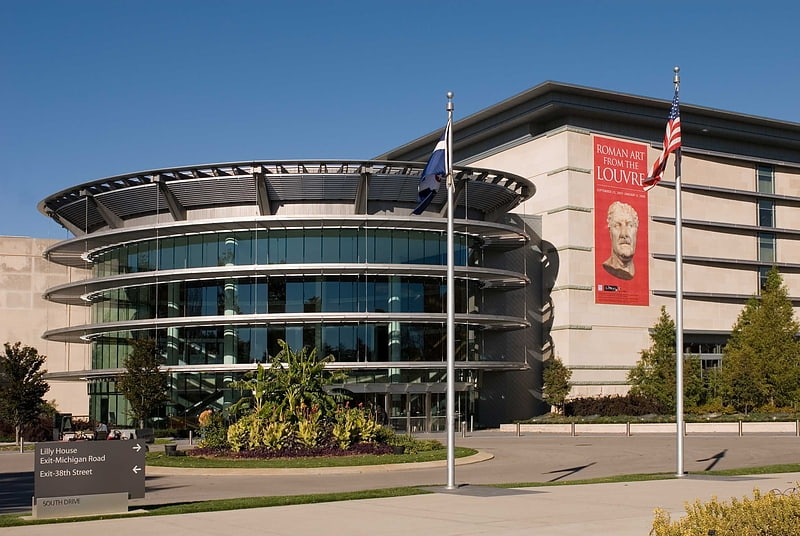
Museum in Indianapolis, Indiana. The Indianapolis Museum of Art is an encyclopedic art museum located at Newfields, a 152-acre campus that also houses Lilly House, The Virginia B. Fairbanks Art & Nature Park: 100 Acres, the Gardens at Newfields, the Beer Garden, and more. It is located at the corner of North Michigan Road and West 38th Street, about three miles north of downtown Indianapolis, northwest of Crown Hill Cemetery. There are exhibitions, classes, tours, and events, many of which change seasonally. The entire campus was previously referred to as the Indianapolis Museum of Art, but in 2017 the campus and organization were renamed "Newfields" to better reflect the breadth of offerings and venues. The "Indianapolis Museum of Art" now specifically refers to the main art museum building that acts as the cornerstone of the campus, as well as the legal name of the organization doing business as Newfields.
The Indianapolis Museum of Art is the ninth oldest and eighth largest encyclopedic art museum in the United States. The permanent collection comprises over 54,000 works, including African, American, Asian, and European pieces. Significant areas of the collection include: Neo-Impressionist paintings; Japanese paintings of the Edo period; Chinese ceramics and bronzes; paintings, sculptures, and prints by Paul Gauguin and the Pont-Aven School; a large number of works by J. M. W. Turner; and a growing contemporary art collection. Other areas of emphasis include textiles and fashion arts as well as a recent focus on modern design.
Founded in 1883 by the Art Association of Indianapolis, the first permanent museum was opened in 1906 as part of the John Herron Art Institute. In 1969, the Art Association of Indianapolis changed its name to the Indianapolis Museum of Art, and in 1970 the museum moved to its current location. Among the Art Association's founders was May Wright Sewall (1844–1920), known for her work in the women's suffrage movement. Other supporters have included Booth Tarkington (1869–1946), Eli Lilly (1885–1977), Herman C. Krannert (1887–1972), and Caroline Marmon Fesler (1878–1960). The associated John Herron Art Institute was established with the help of notable Hoosier Group artists T. C. Steele and William Forsyth.
The museum is widely recognized as innovative in its development of open source technologies, institutional transparency, and collaboration between museums. In 2008, the IMA became the first fine art museum to be named an Energy Star partner due to its greening initiative and efforts to reduce energy consumption. In 2009, the IMA was awarded the National Medal for Museum and Library Service for public service, specifically the museum's free admission policy and educational programming. The free admission policy ended in late 2014 after seven years to maintain long-term financial stability.[2]
Address: 4000 N Michigan Rd, 46208 Indianapolis
Eiteljorg Museum of American Indians and Western Art
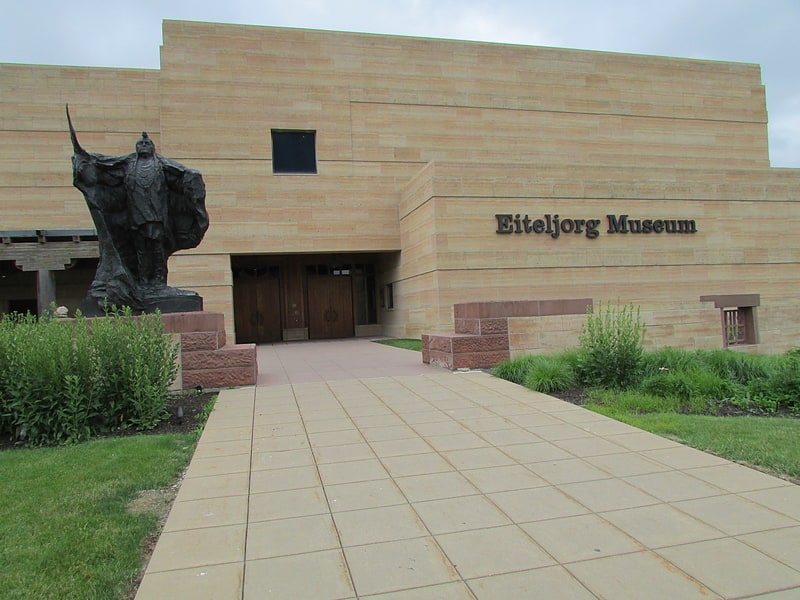
Museum in Indianapolis, Indiana. The Eiteljorg Museum of American Indians and Western Art is located in downtown Indianapolis, Indiana, and houses an extensive collection of visual arts by indigenous peoples of the Americas, as well as Western American paintings and sculptures collected by businessman and philanthropist Harrison Eiteljorg. The museum houses one of the finest collections of Native contemporary art in the world.[3]
Address: 500 W Washington St, 46204 Indianapolis (Downtown Indianapolis)
Indianapolis Motor Speedway Museum
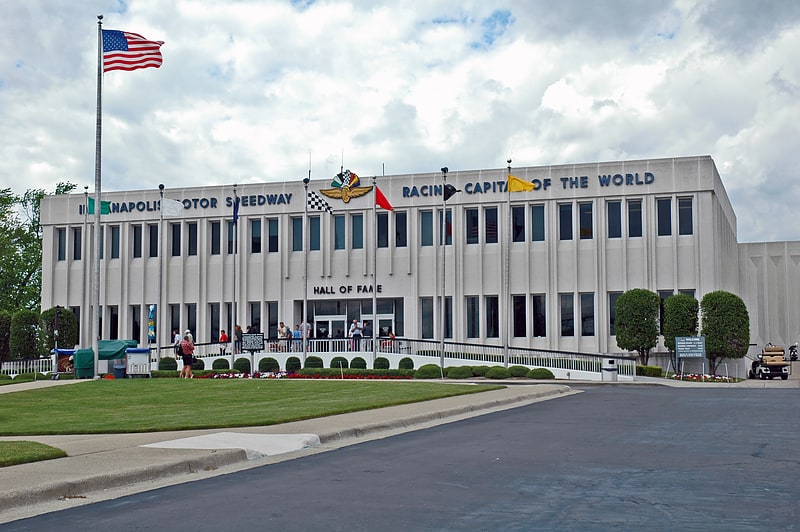
Museum in Speedway, Indiana. The Indianapolis Motor Speedway Museum is an automotive museum on the grounds of the Indianapolis Motor Speedway in Speedway, Indiana, United States, which houses the Indianapolis Motor Speedway Hall of Fame. It is intrinsically linked to the Indianapolis 500 and Brickyard 400, but it also includes exhibits reflecting other forms of motorsports, passenger cars, and general automotive history. In 2006, it celebrated its 50th anniversary. The museum foundation possesses several former Indianapolis 500-winning cars, and they are regularly rotated onto the display floor exhibits.
The museum is independently owned and operated by the Indianapolis Motor Speedway Foundation, Inc. a registered 501(c)(3) organization. The museum dates back to 1956, and moved to the current building in 1976. It is located in the infield of the Indianapolis Motor Speedway race course, and is open year-round, except on certain holidays including Thanksgiving and Christmas.[4]
Address: 4750 W 16th St, 46222 Indianapolis (West Side)
Indianapolis Art Center
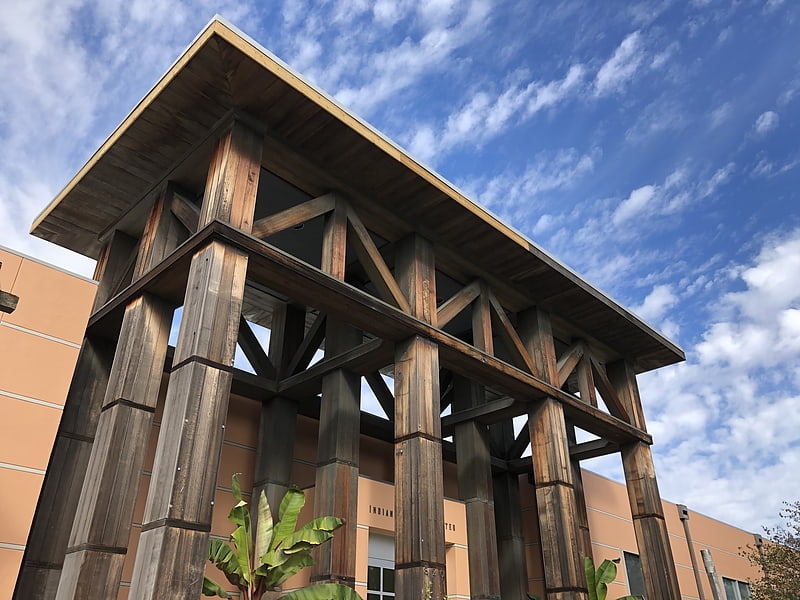
Art gallery in Indianapolis, Indiana. The Indianapolis Art Center is an art center located in Indianapolis, Indiana, United States. The Center, founded in 1934 by the Works Project Administration during the Great Depression as the Indianapolis Art League, is located along the White River. It features fine art exhibitions, art classes and studios, a library with over 5,000 titles, and the ARTSPARK nature and art parks. As of 2008 the Indianapolis Art Center featured over 50 annual exhibitions and had over 3,000 members.[5]
Address: 820 E 67th St, 46220-1199 Indianapolis
Hinkle Fieldhouse
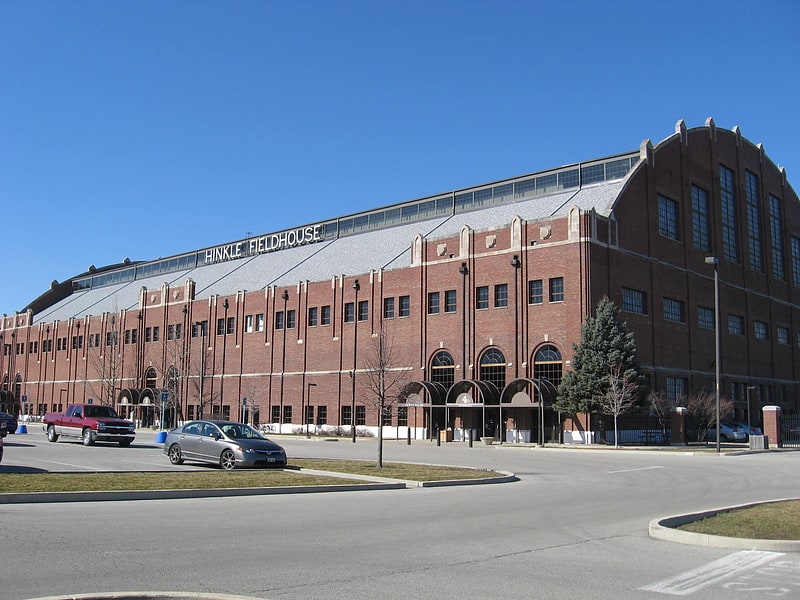
Arena in Indianapolis, Indiana. Hinkle Fieldhouse is a basketball arena on the campus of Butler University in Indianapolis, Indiana. Completed in early 1928, it was the largest basketball arena in the United States until 1950. The facility was renamed Hinkle Fieldhouse in 1966 in honor of Butler's longtime coach and athletic director, Paul D. "Tony" Hinkle. It is the sixth-oldest college basketball arena still in use. Added to the National Register of Historic Places in 1983 and designated a U.S. National Historic Landmark in 1987, Hinkle Fieldhouse is sometimes referred to as "Indiana's Basketball Cathedral."
Hinkle Fieldhouse has served as the home court for the Butler Bulldogs men's basketball team since 1928 (with the exception of 1943 to 1945, when it was converted to a military barracks during World War II) and as the site of the annual Indiana High School Boys Basketball Tournament's championship games from 1928 to 1971. In addition to amateur and professional basketball games, it has hosted visits from U.S. presidents, indoor track events and bicycle races, professional tennis matches, circuses, and other civic and religious gatherings.
The Butler Bulldogs men's basketball team won the Horizon League conference title at Hinkle in 2010. Several memorable high school basketball championship games were played at the Butler arena, including the 1954 title game, when tiny Milan High School's basketball team defeated a larger Muncie Central High School team. Milan's team served as the inspiration for the movie Hoosiers (1986), and the final scenes of the film's championship game were filmed at Hinkle Fieldhouse.[6]
Address: 510 W 49th St, 46208-3480 Indianapolis
Soldiers and Sailors Monument
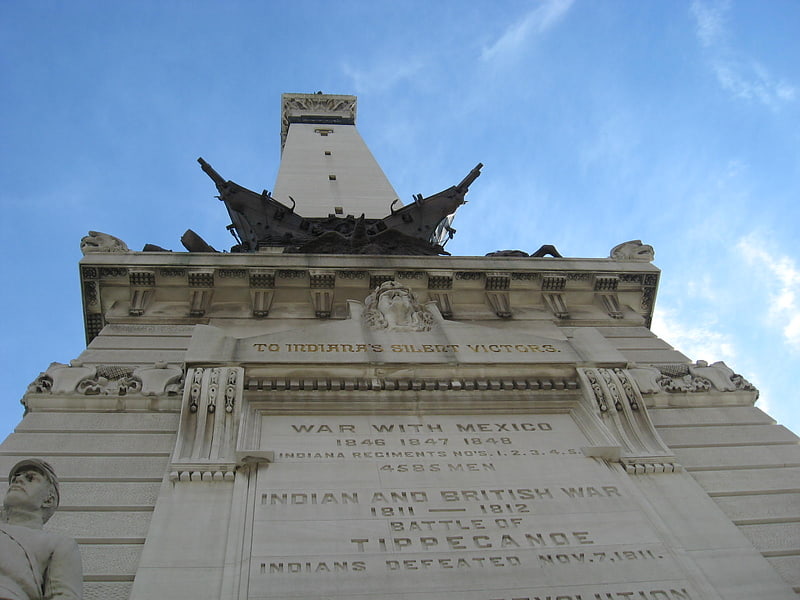
Iconic site with a museum and scenic views. The Indiana State Soldiers and Sailors Monument is a 284 ft 6 in tall neoclassical monument built on Monument Circle, a circular, brick-paved street that intersects Meridian and Market streets in the center of downtown Indianapolis, Indiana. In the years since its public dedication on May 15, 1902, the monument has become an iconic symbol of Indianapolis, the state capital of Indiana. It was added to the National Register of Historic Places on February 13, 1973 and was included in an expansion of the Indiana World War Memorial Plaza National Historic Landmark District in December 2016. It is located in the Washington Street-Monument Circle Historic District. It is also the largest outdoor memorial and the largest of its kind in Indiana.
It was designed by German architect Bruno Schmitz and built over a thirteen-year period, between 1888 and 1901. The monument's original purpose was to honor Hoosiers who were veterans of the American Civil War; however, it is also a tribute to Indiana's soldiers who served during the American Revolutionary War, territorial conflicts that partially led to the War of 1812, the Mexican–American War, and the Spanish–American War. The monument is the first in the United States to be dedicated to the common soldier. The obelisk-shaped monument is built of oolitic limestone from Owen County, Indiana. It rests on a raised foundation surrounded by pools and fountains. Broad stone steps on its north and south sides lead to two terraces at its base. Stone tablets above the bronze entrance doors on the obelisk's north and south sides bear inscriptions commemorating Indiana's soldiers. An inscription above the tablets reads: "To Indiana's Silent Victors." An observation deck is accessible by stairs or elevator from the interior.Its commemorative statuary and fountains are made primarily of oolitic limestone and bronze. At the time of the monument's dedication in 1902, its cost was $598,318. It has been estimated that construction of a similar structure in 2014 would exceed $500 million.
The memorial includes several notable outdoor sculptures, including Rudolph Schwarz's two massive limestone groupings of War and Peace, two smaller scenes named The Dying Soldier and The Return Home, and four military figures at its base. Three astragals, one by Nikolaus (Nicolaus) Geiger and two others by George T. Brewster, surround the stone obelisk. Additional sculptures include John H. Mahoney's bronze statues of George Rogers Clark, William Henry Harrison, and James Whitcomb, and Franklin Simmons's bronze statue of Oliver P. Morton. Brewster's 30-foot (9.1 m) bronze statue of Victory crowns the obelisk. The Indianapolis monument is approximately 21 feet (6.4 m) shorter than New York City's 305-foot (93 m) Statue of Liberty.[7]
Address: 100 Monument Cir, 46204-2904 Indianapolis (Downtown Indianapolis)
Indianapolis Zoo
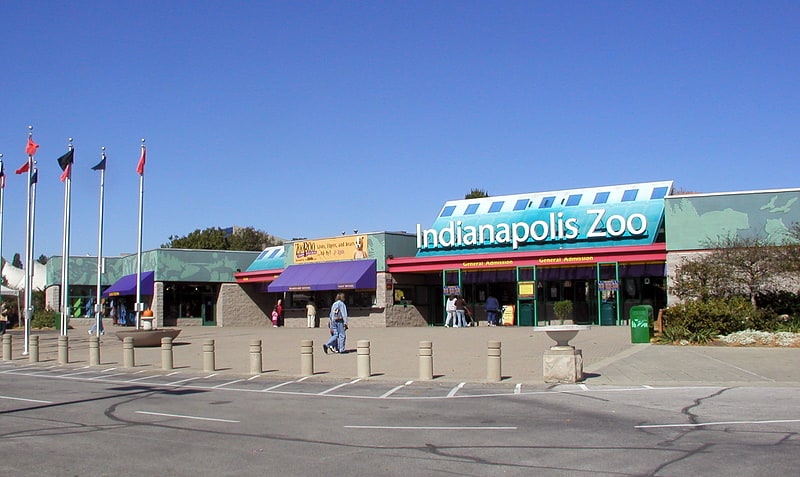
Zoo in Indianapolis, Indiana. The Indianapolis Zoo is a zoo located in White River State Park, in Indianapolis, Indiana, United States, housing more than 3,800 animals of more than 320 species and subspecies. The institution is accredited by the Association of Zoos and Aquariums and the American Alliance of Museums as a zoo, an aquarium, and as a botanical garden. The zoo is a private non-profit organization, receiving no tax support and is supported entirely by membership fees, admissions, donations, sales, grants, and an annual fundraiser.[8]
Address: 1200 W Washington St, 46222-4500 Indianapolis (West Side)
Victory Field

Ballpark in Indianapolis, Indiana. Victory Field is a minor league ballpark in Downtown Indianapolis, Indiana, United States. It is home to the Indianapolis Indians of the International League.[9]
Address: 501 W Maryland St, 46225-1041 Indianapolis (Downtown Indianapolis)
Indiana Farmers Coliseum
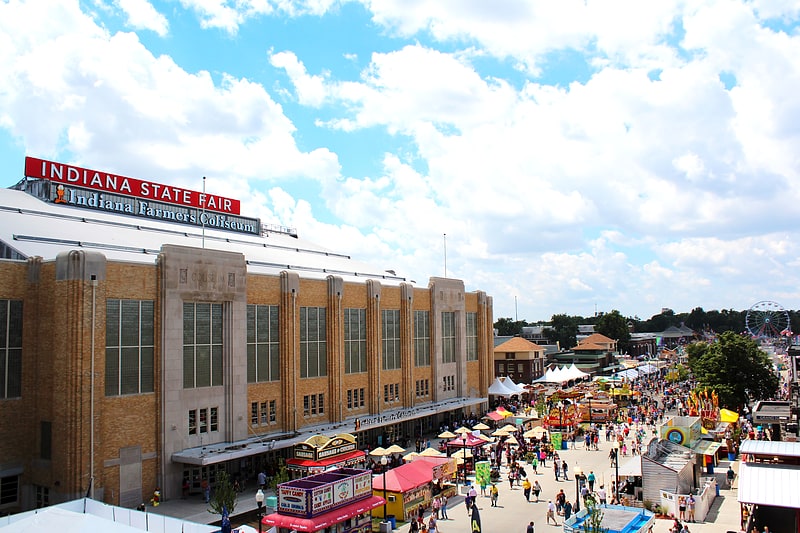
Arena in Indianapolis, Indiana. The Indiana Farmers Coliseum is a 6,500-seat indoor multi-use arena, located on the Indiana State Fairgrounds in Indianapolis. The Indiana Farmers Coliseum is home to both the Indy Fuel of the ECHL and the IUPUI Jaguars of the NCAA.
Originally opened in 1939 as part of President Franklin D. Roosevelt's Works Progress Administration (part of the New Deal), the Coliseum has hosted numerous historical events, including the only performances ever held in Indiana by The Beatles, in 1964.
After Market Square Arena opened in 1974, the coliseum continued on as an alternate venue to the larger arena for events requiring less seating or overall space. This continues today after the Gainbridge Fieldhouse opened in 1999, and the subsequent demolition of Market Square Arena in 2001.
On October 26, 2012, the Coliseum held a "Lights Out" ceremony and closed for renovations. On April 24, 2014, after a 17-month, $53 million renovation, the Coliseum re-opened.
In December 2014, the Indiana Farmers Mutual Insurance Company entered into a ten-year agreement with the Indiana State Fair Commission to re-christen the arena as the Indiana Farmers Coliseum.[10]
Address: Indianapolis, 1202 E. 38th St. Indianapolis, Indiana, U.S.
Monon Trail
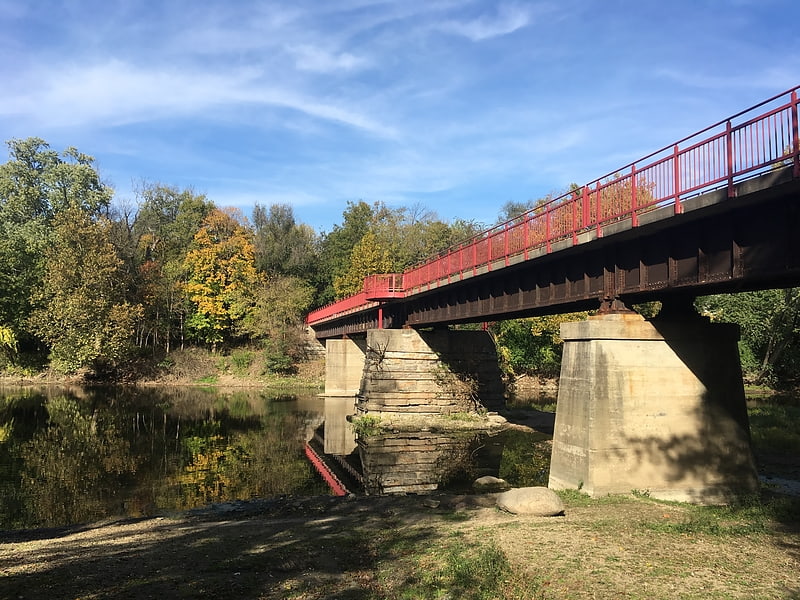
The Monon Trail is a rail trail located entirely within the state of Indiana. The Monon Railroad was a popular railroad line connecting the cities of Chicago and Indianapolis, with stops at major settlements along its route. After the decline of railroad travel and the sale of the company in 1987, the portion of the line between Indianapolis and Delphi, Indiana, was abandoned.
In Northwest Indiana, the trail is 4.4 miles (7.1 km) long, running through Lake County from Munster to Hammond. In the Indianapolis area, the trail consists of 18.1 miles (29.1 km) running through Hamilton and Marion counties, connecting Indianapolis, Carmel and Westfield. The trail has been extended to Sheridan, making the total length 24 miles (39 km).
The first portions of the trail were created in the late 1990s, but it has been consistently extended in both of its segments since then. The trail is a shared use path complete with trailheads, park amenities and local attractions near it.[11]
Address: Monon Tr, 46220 Indianapolis
Indiana War Memorial
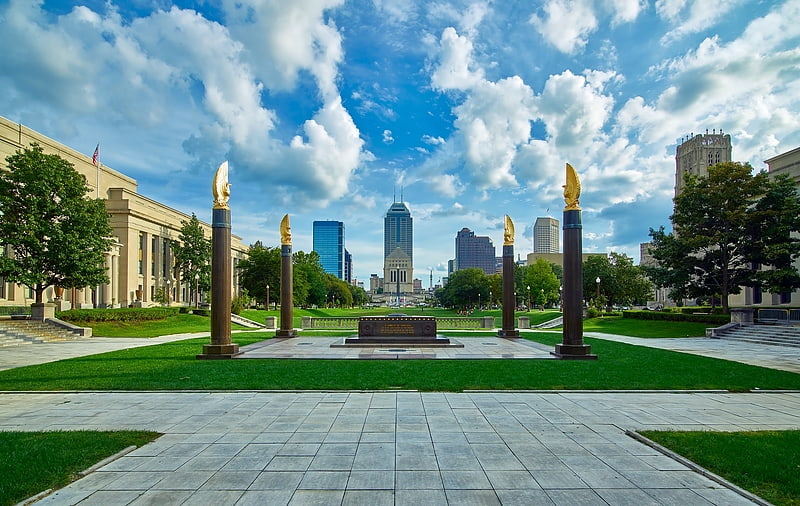
Historical landmark in Indianapolis, Indiana. The Indiana World War Memorial Plaza is an urban feature located in Indianapolis, Indiana, United States, originally built to honor the veterans of World War I. The five-city-block plaza was conceived in 1919 as a location for the national headquarters of the American Legion and a memorial to the state's and nation's veterans. At the north end of the plaza is the American Legion Mall, which is the site of the administration buildings of the Legion, as well as a memorial cenotaph. South of that is the Veterans Memorial Plaza with its obelisk. Combined, it is the largest war memorial project in the United States.
The centerpiece of the plaza is the Indiana World War Memorial, modeled after the Mausoleum of Halicarnassus, which contains "the Altar of the Flag" in the Shrine Room. There is also a military museum and an auditorium. At the south end is University Park, the oldest part of the plaza, filled with statues and a fountain. On October 11, 1994, the Indiana World War Memorial Plaza was designated a National Historic Landmark District. In 2016, the district was enlarged to include in its scope the Soldiers' and Sailors' Monument and was renamed the Indiana World War Memorial Historic District.[12]
Address: 51 E Michigan St, 46204 Indianapolis (Downtown Indianapolis)
Broad Ripple Park Carousel

Broad Ripple Park Carousel is an antique carousel in The Children's Museum of Indianapolis. It was installed in 1917 at an amusement park near the White River in Indianapolis, Indiana, where it remained until the building housing it collapsed in 1956. The ride's mechanism was destroyed, but the animals were relatively unscathed and put into storage by the park's owners, the Indianapolis Department of Parks and Recreation. The animals were carved by the Dentzel Carousel Company some time before 1900 but were assembled by the William F. Mangels carousel company, which also supplied the engine powering the ride.
The Children's Museum of Indianapolis acquired its first two carved animals from the ride in 1965, and the last few wooden animals in 1973. The museum planned to sell some to finance the restoration of others until the director of the museum, Mildred Compton, was convinced by carousel enthusiasts that the museum should instead restore all the animals and recreate the working carousel. Restoration of the carved animals began in 1966 and was only finished with the restoration of the entire carousel in 1977. No space had been allocated for the display of such a large exhibit in the museum's planned new building, which meant some re-designing was necessary to allow its installation on the fifth floor. A 1919 Wurlitzer band organ model #146-B, a type manufactured only for carousels, was also installed. As restored, the carousel is 42 feet (13 meters) wide and has a total of 42 animals, including – as well as the usual horses – goats, giraffes, deer, a lion, and a tiger. It was designated a National Historic Landmark in 1987.[13]
Address: 3000 N Meridian St, 46208 Indianapolis (North Side)
Crown Hill Cemetery
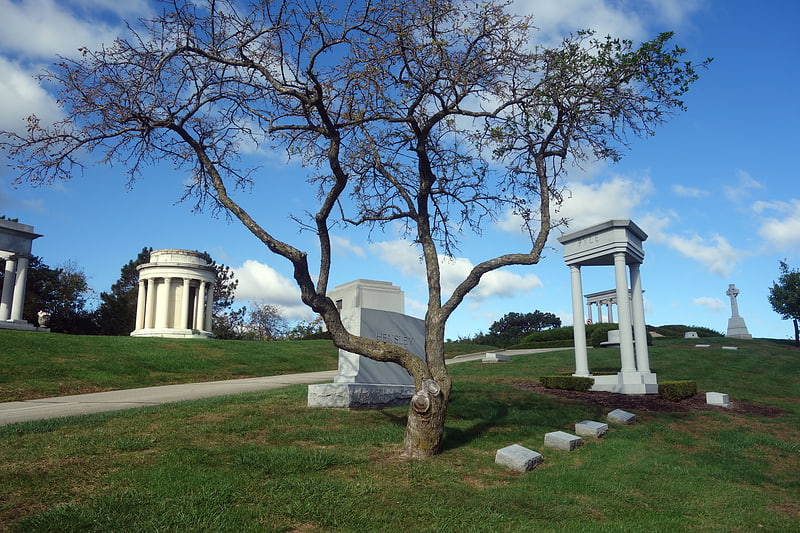
Cemetery. Crown Hill Cemetery is a historic rural cemetery located at 700 West Thirty-Eighth Street in Indianapolis, Marion County, Indiana. The privately owned cemetery was established in 1863 at Strawberry Hill, whose summit was renamed "The Crown", a high point overlooking Indianapolis. It is approximately 2.8 miles northwest of the city's center. Crown Hill was dedicated on June 1, 1864, and encompasses 555 acres, making it the third largest non-governmental cemetery in the United States. Its grounds are based on the landscape designs of Pittsburgh landscape architect and cemetery superintendent John Chislett Sr. and Adolph Strauch, a Prussian horticulturalist. In 1866 the U.S. government authorized a U.S. National Cemetery for Indianapolis. The 1.4-acre Crown Hill National Cemetery is located in Sections 9 and 10.
Crown Hill contains 25 miles (40 km) of paved road, over 150 species of trees and plants, over 225,000 graves, and services roughly 1,500 burials per year. Crown Hill is the final resting place for individuals from all walks of life, from political and civic leaders to ordinary citizens, infamous criminals, and unknowns. Benjamin Harrison, twenty-third president of the United States, and Vice Presidents Charles W. Fairbanks, Thomas A. Hendricks, and Thomas R. Marshall are buried at Crown Hill. Infamous bank robber and "Public Enemy #1" John Dillinger is another internee. The gravesite of Hoosier poet James Whitcomb Riley overlooks the city from "The Crown".
Many of the cemetery's mausoleums, monuments, memorials, and structures were designed by architects, landscape designers, and sculptors such as Diedrich A. Bohlen, George Kessler, Rudolf Schwarz, Adolph Scherrer, and the architectural firms of D. A. Bolen and Son and Vonnegut and Bohn, among others. Works by contemporary sculptors include David L. Rodgers, Michael B. Wilson, and Eric Nordgulen.
The cemetery's administrative offices, mortuary, and crematorium are located at Thirty-eighth and Clarenden streets on the cemetery's north grounds. Crown Hill's Waiting Station, built in 1885 at its east entrance on Thirty-fourth Street and Boulevard Place, serves as a meeting place for tours and programs. The Crown Hill Heritage Foundation, a nonprofit corporation established in 1984, raises funds to preserve the cemetery's historic buildings and grounds. Crown Hill Cemetery was listed on the National Register of Historic Places on February 28, 1973.[14]
Indiana State Museum
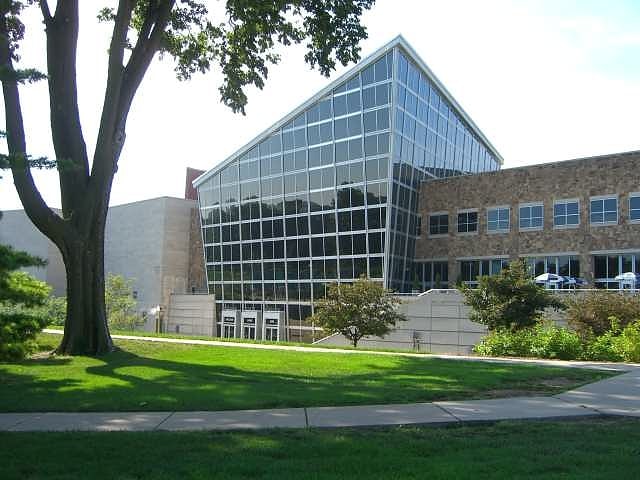
Museum in Indianapolis, Indiana. The Indiana State Museum is a museum located within White River State Park in downtown Indianapolis, Indiana, United States. The museum houses exhibits on the science, art, culture, and history of Indiana from prehistoric times up to the present day. The museum is also the site of the state's largest IMAX screen.[15]
Address: 650 W Washington St, 46204 Indianapolis (Downtown Indianapolis)
Gainbridge Fieldhouse
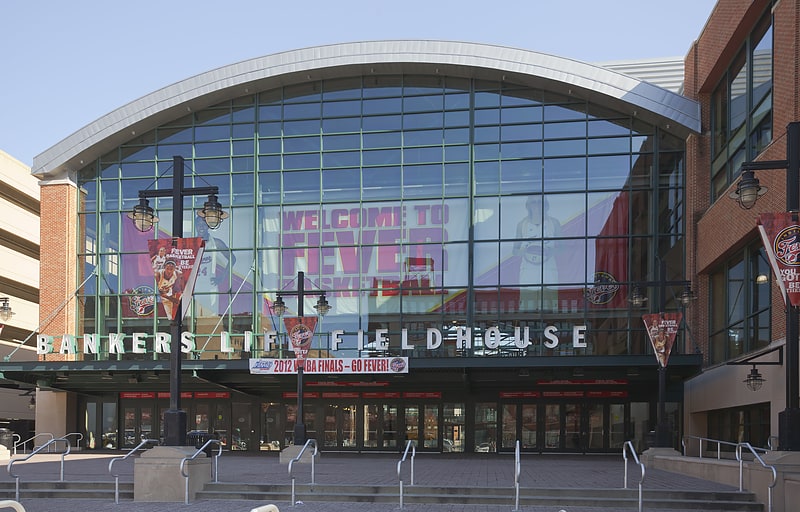
Arena in Indianapolis, Indiana. Gainbridge Fieldhouse is an indoor arena located in downtown Indianapolis, Indiana, United States. It opened in November 1999 to replace Market Square Arena. The arena is the home of the Indiana Pacers of the National Basketball Association and the Indiana Fever of the Women's National Basketball Association. The fieldhouse also hosts college basketball games, indoor concerts, and ice hockey.
The arena was originally named Conseco Fieldhouse, as the naming rights to the venue were sold to Conseco, a financial services organization based in nearby Carmel. In May 2010, the company renamed itself as CNO Financial Group, but the fieldhouse retained the Conseco name. In December 2011, CNO Financial Group changed the name of the fieldhouse to Bankers Life Fieldhouse, after one of its subsidiaries, Bankers Life and Casualty. CNO decided not to renew its naming sponsorship after it expired on June 30, 2019. On September 27, 2021, the fieldhouse announced that Indianapolis-based financial platform Gainbridge would be the new naming partner for the fieldhouse in a multi-year partnership.
In April 2019, the Marion County Capital Improvement Board approved a major renovation project for the fieldhouse. The $360 million project will include a new outdoor entry plaza, new indoor gathering areas, and various interior enhancements. The Pacers committed to remaining in Indianapolis for at least 25 more years as part of the renovation agreement. Construction will take place in two phases, with the fieldhouse having planned to host the 2021 NBA All-Star Game in between the phases, which was later canceled due to the COVID-19 pandemic. Almost all of the construction work will take place during Pacers offseasons. The project will displace the Fever for all of the 2020 and 2021 WNBA seasons, as well as at least part of the 2022 season; the Fever played the first section of the schedule at Gainbridge Fieldhouse, but after the NBA season ended, the Fever played games at Indiana Farmers Coliseum.
The arena was built to evoke an Indiana high school and college field house. As such, unlike most other North American sports arenas, it was designed primarily for basketball. The arena can accommodate an NHL-sized rink, but the ice hockey seating capacity is reduced to 12,300 in an asymmetrical configuration.[16]
Address: Indianapolis, 125 South Pennsylvania Street
St. John the Evangelist Catholic Church
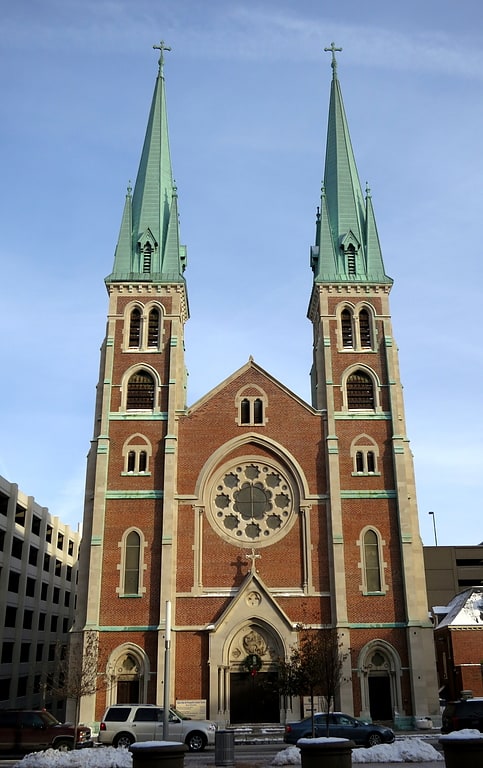
Catholic church in Indianapolis, Indiana. Saint John the Evangelist Catholic Church is a Roman Catholic parish of the Archdiocese of Indianapolis in Indianapolis, Indiana, United States. The parish's origins date to 1837, when it was first named Holy Cross parish. In 1850 it was renamed Saint John the Evangelist parish, and is the oldest Catholic parish in the city and in Marion County, Indiana. Considered the mother of the Catholic parishes in Indianapolis, it played an important role in development of the Catholic Church in the city. Saint John's Church served as the pro-cathedral of the diocese from 1878 until 1906; its rectory served as the bishop's residence and chancery from 1878 until 1892. In 1900 the church served as the site of first episcopal consecration held in Indianapolis.
Although many considered Saint John's a diocesan cathedral, it was never officially named as such. Saint Francis Xavier Cathedral remained the official cathedral and Vincennes, Indiana, as the see city for the Roman Catholic Diocese of Vincennes, Indiana, until March 28, 1898, when the episcopal see was transferred to Indianapolis and became the Diocese of Indianapolis. Diocesan functions continued to be held at Saint John's until Saints Peter and Paul Cathedral was built in 1906. Saint John's rectory continued to house the diocesan chancery until 1968, and served as the metropolitan tribunal for the diocese until 1982. Saint John's Church and rectory were placed on the National Register of Historic Places in 1980.
The present-day Saint John's Church, the parish's third and the second one built on the Georgia Street property, is the main structure in a group of parish buildings on the southwest corner of Georgia Street and Capitol Avenue. Diedrich A. Bohlen, principal and founder of the Indianapolis architectural firm of D. A. Bohlen and Son, designed the rectory (1863), church (1867–71), and a rectory addition (1878). Bohlen's son, Oscar, designed the twin spires and supervised their construction in 1893. The red-brick church has an eclectic style, including elements of French Gothic Revival and American Romanesque Revival architecture. The sanctuary has a seating capacity of 3,000. It was the largest church in Indiana when the cornerstone was laid in 1867; it was dedicated on July 2, 1871.[17]
Address: 126 W Georgia St, 46225-1004 Indianapolis (Downtown Indianapolis)
Christ Church Cathedral
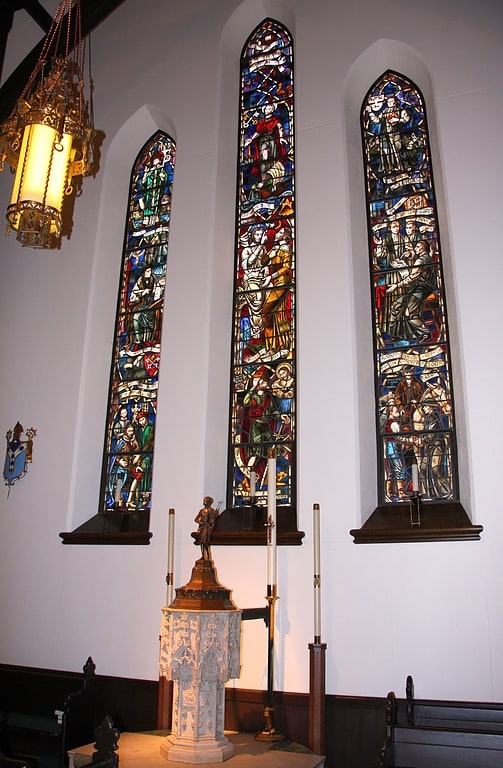
Cathedral in Indianapolis, Indiana. Christ Church Cathedral is the cathedral for the Episcopal Diocese of Indianapolis. Christ Church parish was formally organized in 1837. The present-day church building was erected in 1857 on Monument Circle at the center of downtown Indianapolis to replace the parish's first church built on the same site. Designed by architect William Tinsley, the English Gothic Revival-style structure is the oldest church building in Indianapolis and Marion County, Indiana, that has remained in continuous use. It is also the oldest building on Monument Circle. Christ Church is known for its music, especially its pipe organs, one of which was donated by Ruth Lilly, and its professional Choir of Men and Boys and Girls' Choir. The parish is also known for its community service, including an annual strawberry festival fundraiser and other charitable work. Christ Church Cathedral was added to the National Register of Historic Places on July 10, 1973. It is located in the Washington Street-Monument Circle Historic District.[18]
Address: 125 Monument Cir, 46204-2993 Indianapolis (Downtown Indianapolis)
White River State Park
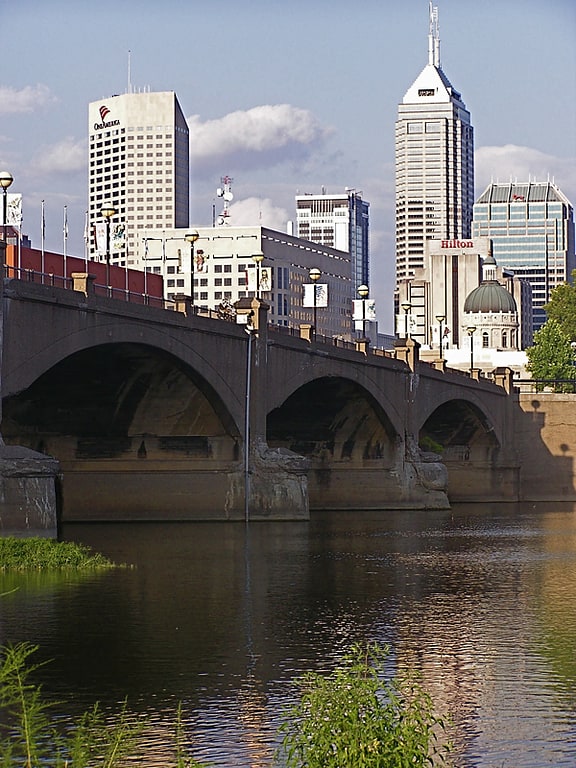
Park in Indianapolis, Indiana. White River State Park is an urban park in Downtown Indianapolis, Indiana. Situated along the eastern and western banks of its namesake White River, the park covers 267 acres. Initial plans for the park were conceived by civic leaders in the late-1970s to capitalize on the city's amateur sports economic development strategy. Bipartisan support from state legislators and seed money from corporate partners led to the organization of a quasi-governmental commission to oversee planning and operations for the park. Construction began in the 1980s with the acquisition and clearing of blighted industrial properties and realignment of Washington Street for redevelopment.
Notable attractions located in the park include the Eiteljorg Museum of American Indians and Western Art, Indiana State Museum, Indianapolis Zoo, Medal of Honor Memorial, NCAA Hall of Champions, Victory Field, and White River Gardens.
The park and accompanying Indianapolis Canal Walk comprise one of seven designated cultural districts.[19]
Address: 801 West Washington Street, Indianapolis (Downtown Indianapolis)
Benjamin Harrison Presidential Site
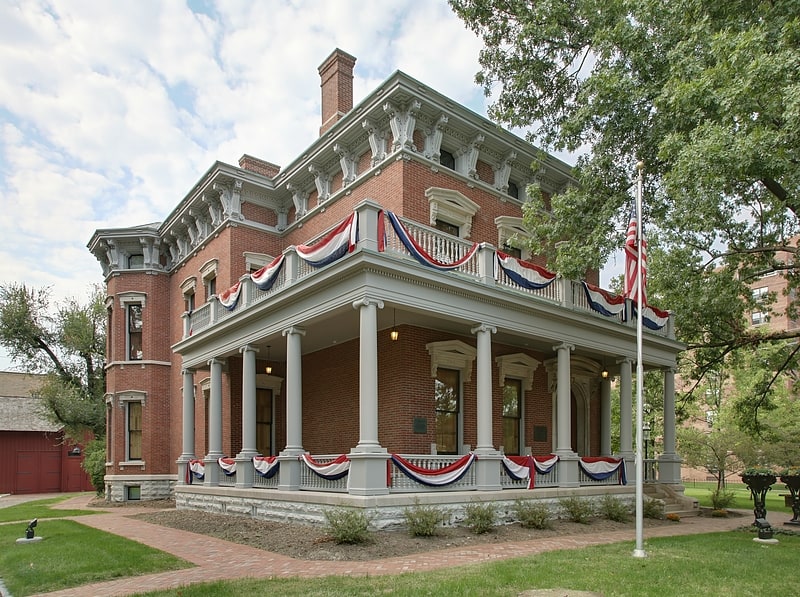
Museum in Indianapolis, Indiana. The Benjamin Harrison Presidential Site, previously known as the Benjamin Harrison Home, is the former home of the twenty-third president of the United States, Benjamin Harrison. It is in the Old Northside Historic District of Indianapolis, Indiana. Harrison had the sixteen-room house with its red brick exterior built in the 1870s. It was from the front porch of the house that Harrison instituted his famous Front Porch Campaign in the 1888 United States presidential campaign, often speaking to crowds on the street. In 1896, Harrison renovated the house and added electricity. He died there in a second story bedroom in 1901. Today it is owned by the Arthur Jordan Foundation and operated as a museum to the former president by the Benjamin Harrison Foundation.[20]
Address: 1230 N Delaware St, 46202-2531 Indianapolis (North Side)
City Market
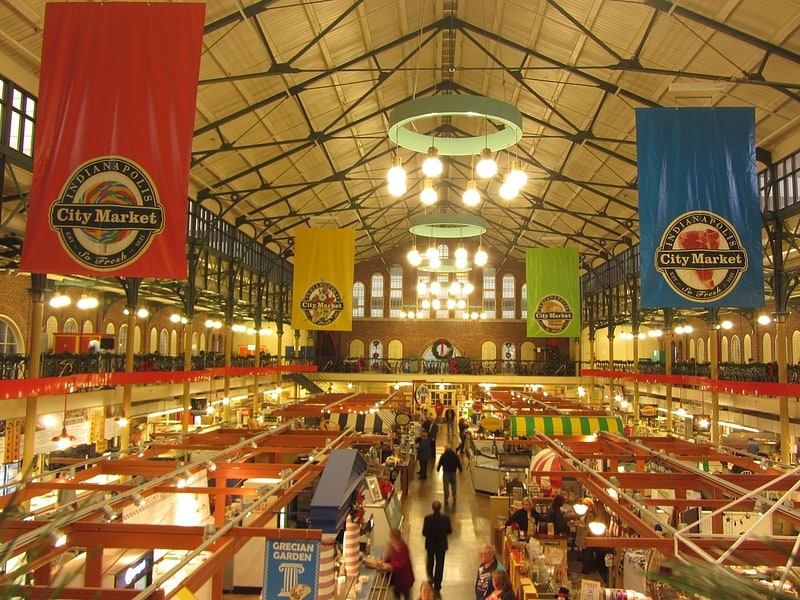
Market. The Indianapolis City Market is a historic public market located in Indianapolis, Indiana. It was founded in 1821 and officially opened in its current facility in 1886. The market building is a one-story, rectangular brick building trimmed in limestone. It has a front gable center section flanked by square towers. While it was originally a farmers market, it is now a food court. The Indianapolis City Market also hosted some events for Super Bowl XLVI in Indianapolis.
The market was listed on the National Register of Historic Places in 1974.[21]
Address: 222 E Market St, 46204-3300 Indianapolis (Downtown Indianapolis)
Oldfields
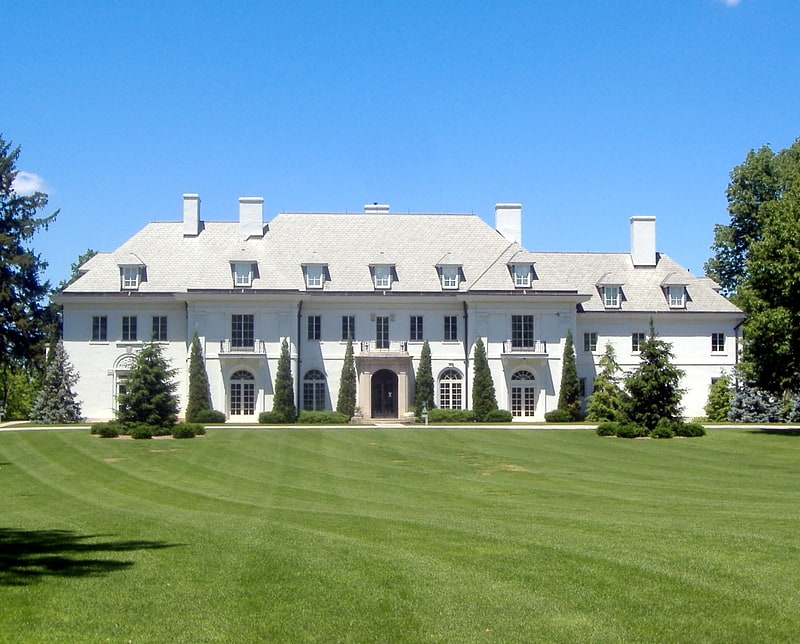
Museum in Indianapolis, Indiana. Oldfields also known as Lilly House and Gardens, is a 26-acre historic estate and house museum at Newfields in Indianapolis, Indiana, United States. The estate, an example of the American country house movement of the late 19th and early 20th centuries, was designated a U.S. National Historic Landmark in 2003.
Oldfields was built between 1909 and 1913 by architect Lewis Ketcham Davis for the family of Hugh McKennan Landon, who occupied the home from 1913 until 1932 when it was sold to Josiah K. Lilly Jr. Lilly, the late Indianapolis businessman, collector, and philanthropist, renovated and expanded the estate throughout the 1930s and 1940s, updating interiors as well as adding a number of new buildings to the grounds.
Now known as Lilly House, the 22-room mansion has undergone historic restoration and is now open to the public. The historic house is currently interpreted to reflect the 1930s era when the Lilly family occupied the residence. The rest of the Oldfields estate, which was given to the Art Association of Indianapolis by Lilly's children in 1967, now makes up a major portion of the Newfields campus. In addition to the home's significance as a representation of the American country house movement, Oldfields' gardens and grounds are a rare example of a preserved estate landscape designed by Percival Gallagher of the Olmsted Brothers firm.[22]
Address: 4000 Michigan Rd, 46208 Indianapolis
James Whitcomb Riley Museum Home
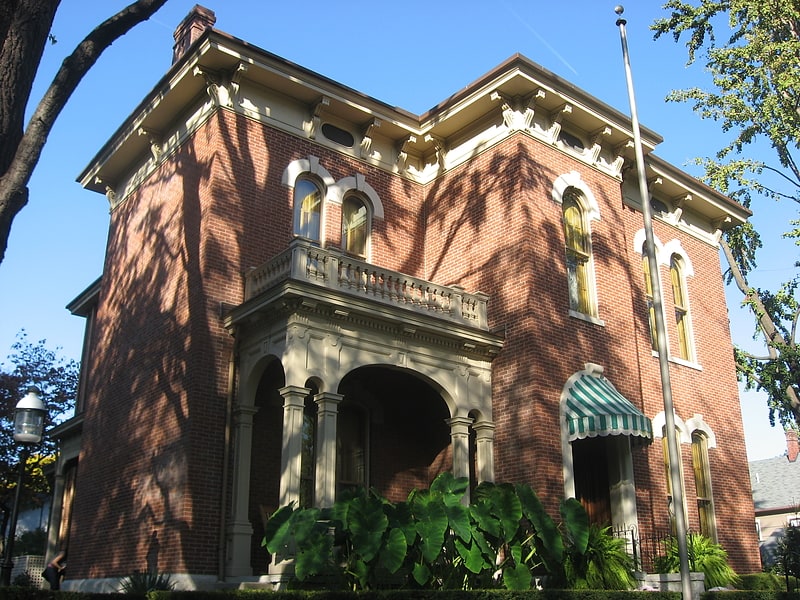
Museum in Indianapolis, Indiana. The James Whitcomb Riley Museum Home, one of two homes known as the James Whitcomb Riley House on the National Register of Historic Places, is a historic building in the Lockerbie Square Historic District of Indianapolis, Indiana. It was named a National Historic Landmark in 1962 for its association with poet James Whitcomb Riley, known as the "Hoosier poet".[23]
Address: 528 Lockerbie St, 46202-3617 Indianapolis (Downtown Indianapolis)
St. Mary's Catholic Church
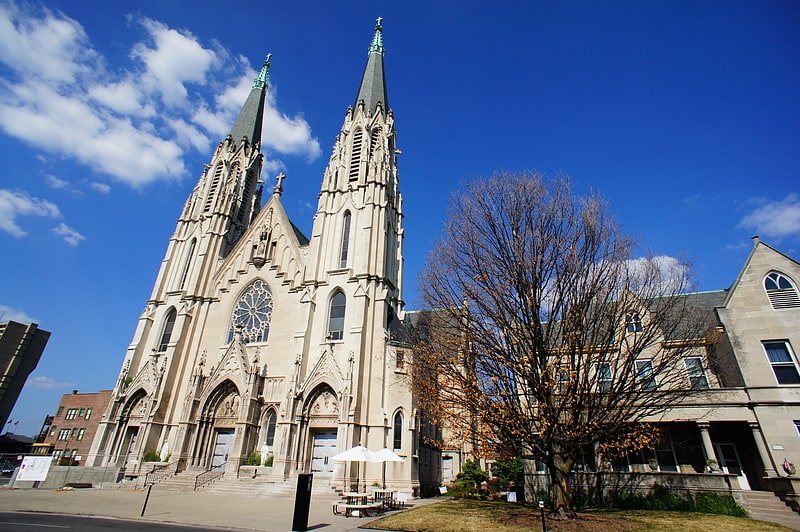
Catholic church in Indianapolis, Indiana. St. Mary Catholic Church is a parish of the Roman Catholic Church in Indianapolis, Indiana, in the Archdiocese of Indianapolis.
Originally founded in 1858 to serve the city's growing German population, it is noted for its historic parish church at the corner of New Jersey and Vermont streets, which was completed in 1912. Designed by architect Hermann J. Gaul in the late Gothic Revival style, it follows a cruciform plan modeled after the Cologne Cathedral in Germany. The church is listed on the National Register of Historic Places.[24]
Address: 317 N New Jersey St, 46204 Indianapolis (Downtown Indianapolis)
Scottish Rite Cathedral
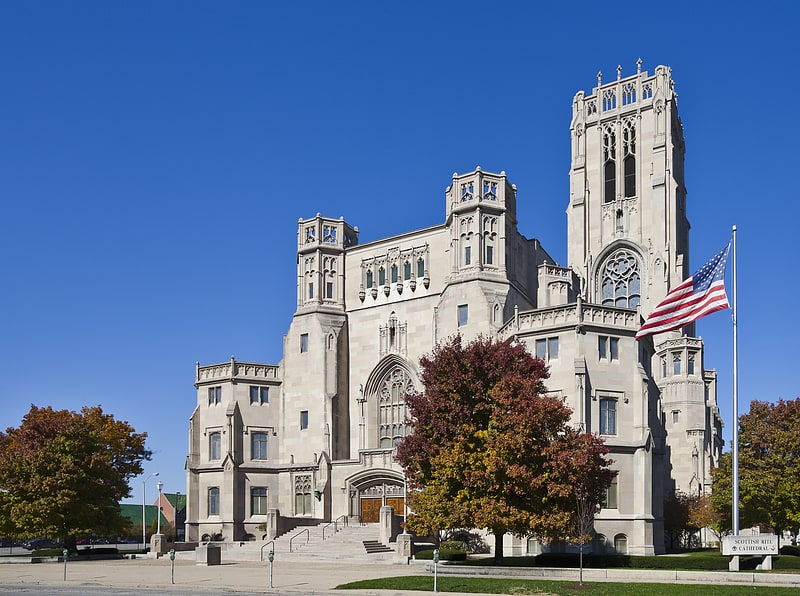
Building in Indianapolis, Indiana. The Scottish Rite Cathedral in Indianapolis, Indiana is a historic building designed by architect George F. Schreiber and located in downtown Indianapolis. It is owned by the Valley of Indianapolis Scottish Rite, an affiliated body of Freemasonry. It was built between 1927 and 1929 at the cost of $2.5 million. Every dimension of the structure is evenly divisible by three, with many also being divisible by 33.
The Cathedral is one of the largest Masonic buildings in the world, and the largest Scottish Rite building anywhere. It has been described as one of the finest examples of Neo-Gothic architecture in the United States. The dominant feature of the exterior is the ‘Singing Tower’ which rises 212 feet above the sidewalk level and contains the Cathedral’s carillon. The carillon consists of 54 bells collectively weighing 56,372 pounds, making it one of the largest in the United States. The top of the tower is ornamented with 12 fleur-de-lis, which from the sidewalk appear to be passion crosses. The four lobes of these fleur-de-lis extend to the north, south, east and west, again symbolizing the universality of Masonry.
The sculptured figures over the main entrance on the building's east side at the base of the tower depict King Solomon of Israel, Hiram I King of Tyre, and three condemned stonemasons from Solomon's Temple. According to Masonic lore, these 'ruffians' murdered King Solomon’s master builder, Hiram Abiff, at the completion of the erection of the Temple at Jerusalem. Other stone carvings depict various aspects of the Scottish Rite, and its motto, “Spes Mea In Deo Est” (My hope is in God), is carved into the limestone lintels above the doors.
At the eastern and southern entrances to the Cathedral, large bronze medallions are set into travertine marble floors. The detailed ornamentation of these embellished centerpieces display the 12 signs of the zodiac and the four principal degrees of Scottish Rite. Together they represent the universality of the Masonic fraternity. The main entrance, known as the Tiler's Room, is a 33-foot (10 m) cube.
Throughout the Cathedral are over 100 'stained glass' windows (actually painted glass) that depict the three craft lodge degrees of Masonry, the degrees of the Scottish Rite, symbols of York Rite Freemasonry, plus images of liberal arts, sciences, and even technology of the 1920s at the time of its construction.
The ballroom is constructed with a floating floor, where the entire floor is laid on felt cushions. This type of construction, also known as a sprung floor, provides 'give' to the floor which tends to relieve dancers' feet. The ballroom also embodies the number 33 by being 99 feet (30 m) square, with pillars defining the dancing area as 66 ft (20 m) square, and the white oak floor panels being 33 in (840 mm) square. The chandelier has 200 lights and weighs 2,500 lb (1,100 kg). The ballroom was designed in an Elizabethan architectural style.
The theater stage features more than 50 hand-painted scenic backdrops for various scenes of the 29 Scottish Rite degree presentations. They are operated by 12 miles of rope. The proscenium arch of the stage is 38 feet wide and 28 feet high. The architecture is Cathedral Gothic, sometimes referred to as Medieval Gothic, and was patterned in large part after the details of the Cologne Cathedral. The woodwork, panels, and trim are Russian curly oak. The wall panels are embellished in Gothic motif and are shaded from dark near the floor to lighter toward the ceiling. These symbolize how Scottish Rite teachings bring its members from darkness to light. The carvings on the trusses and woodwork were created by the sons of Anton Lang who was famous for playing the part of Christ in the passion play at Oberammergau, Germany. The four robust cherubs on each side of the theater and the two on either side of the stage holding plaques to their breasts are symbolic reference to the Ten Commandants. About 1,100 persons can be seated in the theater and another 200 on chairs on the floor in the arena area.
In a 1996 poll, the Indianapolis Business Journal found the Cathedral to be the most popular historic building in the city, and the second favorite building of any type. In recent years it has received about 100,000 visitors a year.
The Valley of Indianapolis is the only Scottish Rite Valley in the nation with an orchestra in residence, the Scottish Rite Orchestra, conducted by Ill. Jeffrey S. Warbinton, 33˚. The orchestra was founded in 1946 by Fabien Sevitzky, then conductor of the Indianapolis Symphony Orchestra.
Indiana's Scottish Rite Masons are a part of the Ancient Accepted Scottish Rite Northern Masonic Jurisdiction. The Cathedral makes up a triad of major Masonic landmarks in downtown Indianapolis, consisting of itself, the Indianapolis Masonic Temple to its south, and the Murat Shrine Center on Alabama Street.
The downstairs features the Double Eagle Cafe that is open to the public on weekdays for lunch. Guided tours of the Cathedral are available on Tuesday through Friday from 10:00 AM to 2:00 PM.[25]
Address: 650 N Meridian St, 46204-1214 Indianapolis (Downtown Indianapolis)
Depew Memorial Fountain
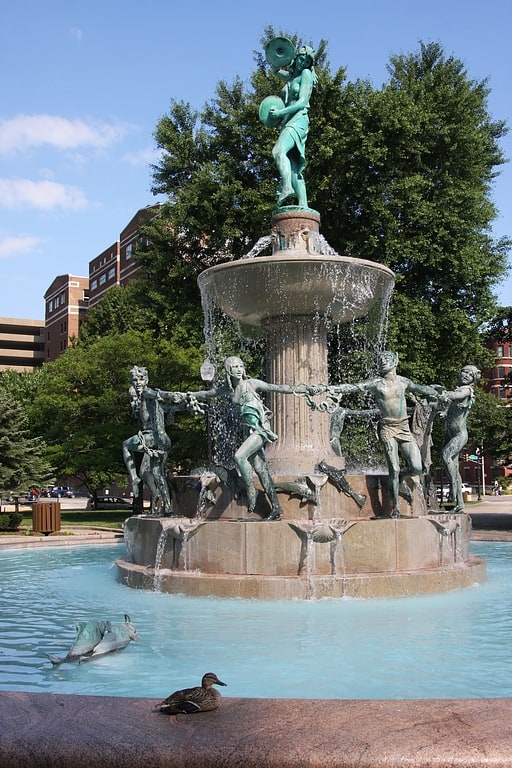
Park in Indianapolis, Indiana. Depew Memorial Fountain is a freestanding fountain completed in 1919 and located in University Park in downtown Indianapolis, Indiana, within the Indiana World War Memorial Plaza.[26]
Indiana Historical Society
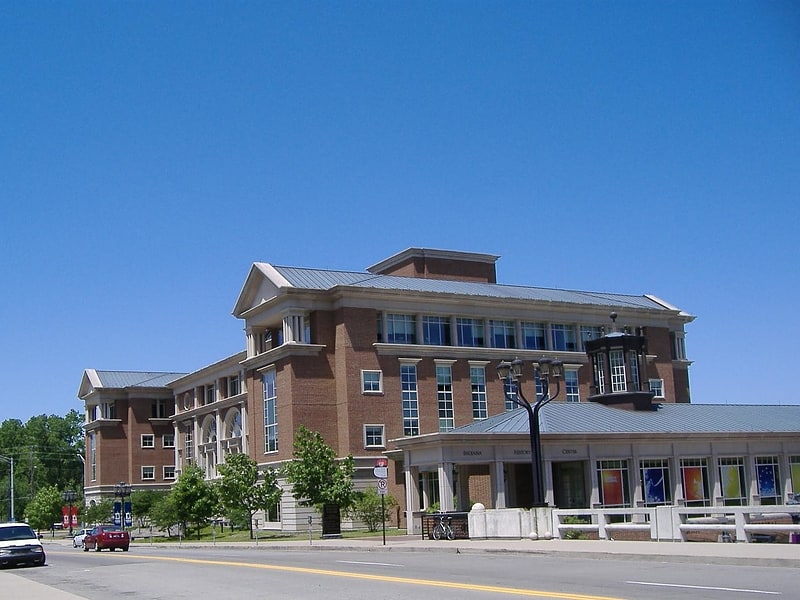
Museum in Indianapolis, Indiana. The Indiana Historical Society is one of the United States' oldest and largest historical societies and describes itself as "Indiana's Storyteller". It is housed in the Eugene and Marilyn Glick Indiana History Center at 450 West Ohio Street in Indianapolis, Indiana, in The Canal and White River State Park Cultural District, neighboring the Indiana State Museum and the Eiteljorg Museum of American Indian and Western Art. In 2019, the center hosted 112,732 visitors. The Indiana Historical Society is the oldest state historical society west of the Allegheny Mountains.
A private, nonprofit membership organization founded in 1830, the IHS maintains a research library and archives on the history of Indiana and the Old Northwest. The IHS also provides support and assistance to local museums and historical groups, publishes books and periodicals; sponsors teacher workshops; and provides youth, adult, and family programming, including Indiana's participation in the National History Day Competition series. Finally, it is responsible for appointing and training the state's 92 county historians. The Indiana Historical Society opened a new 165,000-square-foot (15,300 m2) headquarters in downtown Indianapolis in July 1999, built on the site of the prior Holy Trinity Greek Orthodox Church of Indianapolis.[27]
Address: 450 W Ohio St, 46202-3269 Indianapolis (Downtown Indianapolis)
Indianapolis Artsgarden
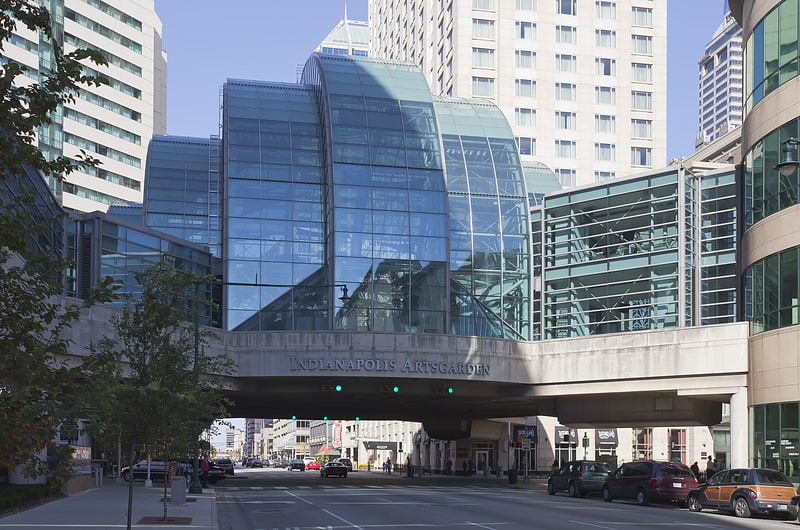
Building in Indianapolis, Indiana. The Indianapolis Artsgarden is a glassed dome spanning the intersection of Washington and Illinois streets in downtown Indianapolis, Indiana. It serves not only as a pedestrian connector between Circle Centre Mall and nearby office buildings and hotels but also as a venue for the display and performance of artistic and musical works. In addition, the Artsgarden houses the Cultural Concierge, which provides local arts and cultural information, maps, and visitor guides. The structure, including the walkways connecting it to the adjacent buildings, is owned and operated by the Arts Council of Indianapolis.
The Artsgarden was designed by Ehrenkrantz Eckstut & Kuhn Architects who also designed the adjacent Circle Centre Mall. Blackburn Architects collaborated on the design and execution. The $12 million cost was funded by the Lilly Endowment.
The floor of the Artsgarden stands 17 feet (5.2 m) above the intersection. A series of arched steel trusses creates a graduated set of glassed vaults, the tallest of which is 75 feet (23 m) above the floor and 95 feet (29 m) above the street. The design yields a total free-span length of 110 feet (34 m) within the dome. A total of 32,000 square feet (3,000 m2) of glass is used in the structure to give it an airy, open feel. The entire dome is set on two pairs of 185-foot (56 m) plate girders that diagonally span the intersection.
When initially constructed in 1995, the Artsgarden connected the second level of Circle Centre Mall on the southeast corner of the intersection with an upper level of the Claypool Courts on the northwest corner, while stairways provided access to the ground-level sidewalks on the northeast and southwest corners. In 2006, the Conrad Indianapolis was built on the site of the small park that had been on the northeast corner and the stairway there was replaced with a direct connection to the hotel. In 2011 construction was started on a connector to the 16-story PNC Center and Hyatt Regency hotel complex on the southwest corner. The owners of the complex in 1995 had declined to help pay for the connector; in 2010 an agreement was reached to split the $1.2 million cost, completing the original concept of the Artsgarden. The connector was completed in January 2012.[28]
Address: 110 W Washington St, 46204-3431 Indianapolis (Downtown Indianapolis)
NCAA Hall of Champions
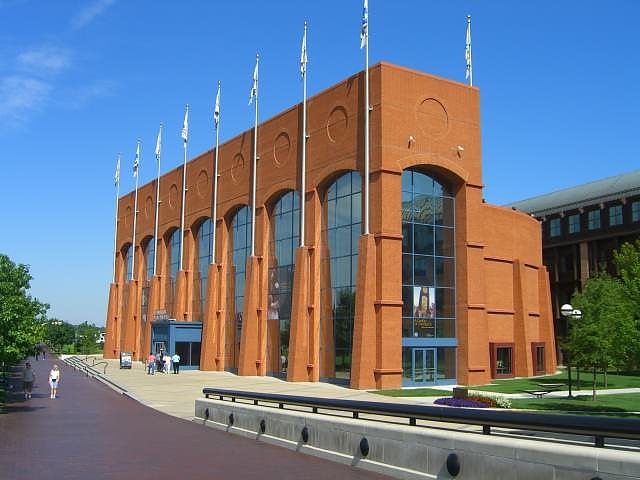
Museum in Indianapolis, Indiana. The NCAA Hall of Champions is an interactive museum and part of a three-building complex that houses a conference center and the corporate headquarters of both the National Collegiate Athletic Association and National Federation of State High School Associations in White River State Park in Indianapolis, Indiana, United States.
It was constructed as part of the NCAA's headquarters relocation to Indianapolis from Kansas City, Missouri. The complex was designed by Indianapolis-native and postmodern architect, Michael Graves. The museum contains a 90-seat orientation theater, two floors of exhibition space, and a gift shop. The grand hall honors collegiate athletes representing the NCAA's 24 sanctioned sports across its three divisions and includes the banners of each member institution.[29]
Address: 700 W Washington - 1 NCAA Plaza, 46204 Indianapolis (Downtown Indianapolis)
Indiana Repertory Theatre
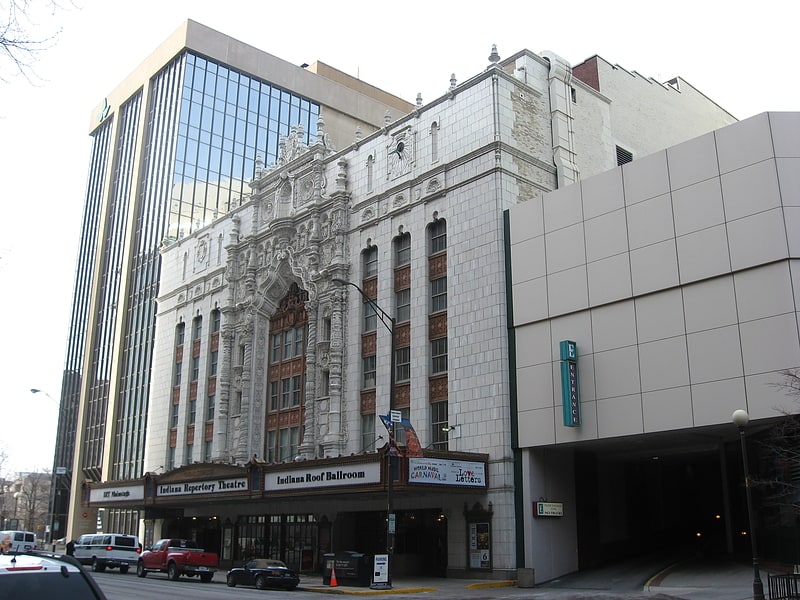
Theatre in Indianapolis, Indiana. Indiana Repertory Theatre, frequently abbreviated IRT, is a professional regional theatre in Indianapolis, Indiana that began as a genuine repertory theatre with its casts performing in multiple shows at once. It has subsequently become a regional theatre and a member of the League of Resident Theatres. A standard season typically consists of nine or ten plays on two different stages and the bulk of its season performed on the OneAmerica Stage.
The theatre company has history in two theatre buildings. It began in 1972 in The Athenaeum. In 1980, the IRT moved to its current home, The Indiana Theatre, a former Paramount Pictures Publix Theatre at 140 West Washington Street, built in 1927 and converted from a movie theater for IRT's use.[30]
Address: 140 W Washington St, 46204-3465 Indianapolis (Downtown Indianapolis)
Bethel A.M.E. Church
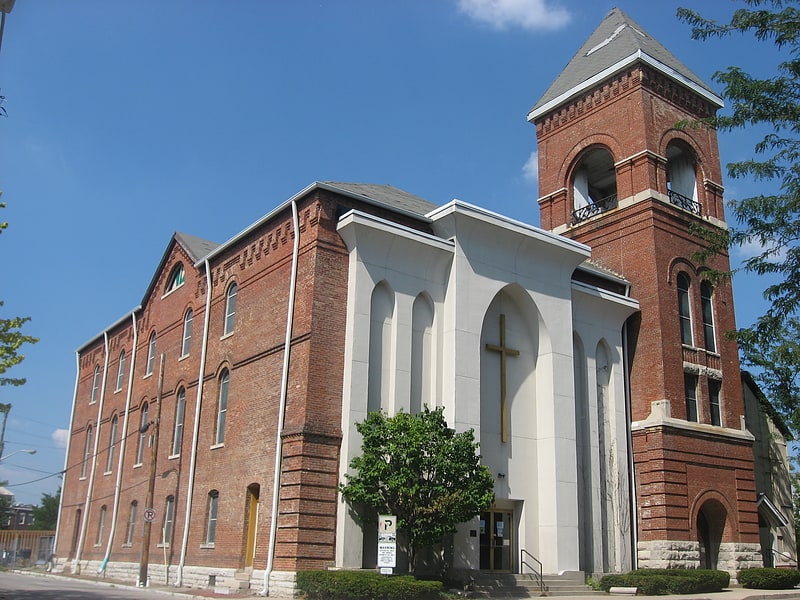
Episcopal church in Indianapolis, Indiana. The Bethel A.M.E. Church, known in its early years as Indianapolis Station or the Vermont Street Church, is a historic African Methodist Episcopal Church in Indianapolis, Indiana. Organized in 1836, it is the city's oldest African-American congregation. The three-story church on West Vermont Street dates to 1869 and was added to the National Register in 1991. The surrounding neighborhood, once the heart of downtown Indianapolis's African American community, significantly changed with post-World War II urban development that included new hotels, apartments, office space, museums, and the Indiana University–Purdue University at Indianapolis campus. In 2016 the congregation sold their deteriorating church, which will be used in a future commercial development. The congregation built a new worship center at 6417 Zionsville Road in Pike Township, Marion County, Indiana.
The Bethel AME congregation has a long history of supporting the city's African American community. It is especially noted for its activities on behalf of the antislavery movement in the years before the American Civil War; its support of the Underground Railroad, which provided protection to slaves en route to Canada; and its commitment to education and community outreach. Bethel also served as the mother church to several AME congregations in Indiana and as a public meeting place in Indianapolis for social activists. Local chapters of the National Association for the Advancement of Colored People and the Indiana State Federation of Colored Women's Clubs were organized at the Vermont Street church in the early 1900s.[31]
Address: 414 W Vermont St, 46202-3215 Indianapolis (Downtown Indianapolis)
White River Gardens
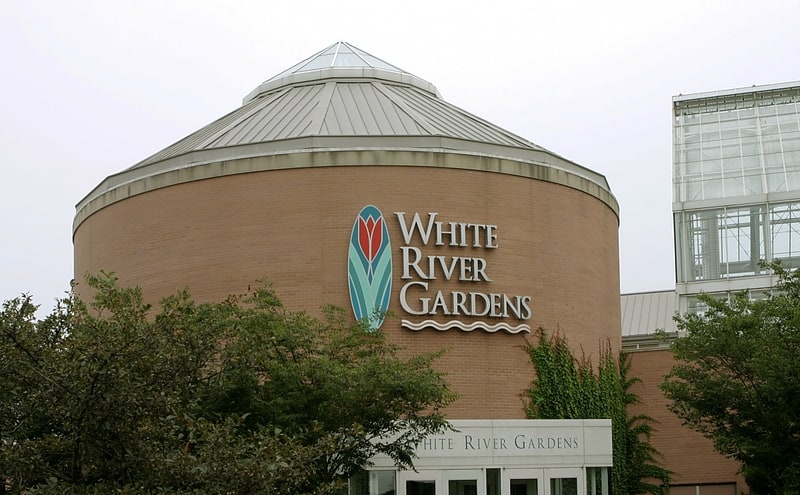
Botanical garden in Indianapolis, Indiana. The White River Gardens are botanical gardens located adjacent to the Indianapolis Zoo in Indianapolis, Indiana, in the United States. The gardens are a part of the White River State Park.[32]
Address: White River State Park | 1200 W Washington St, 46222 Indianapolis (West Side)
Military Park
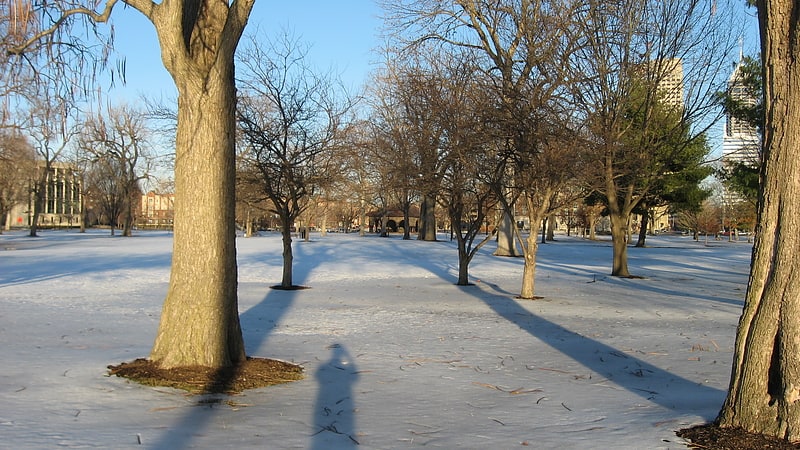
Memorial park in Indianapolis, Indiana. Military Park is the oldest park in Indianapolis, Indiana, covering 14 acres. It is located in western Downtown Indianapolis.[33]
Address: White River State Park, 46204 Indianapolis (Downtown Indianapolis)
Medal of Honor Memorial
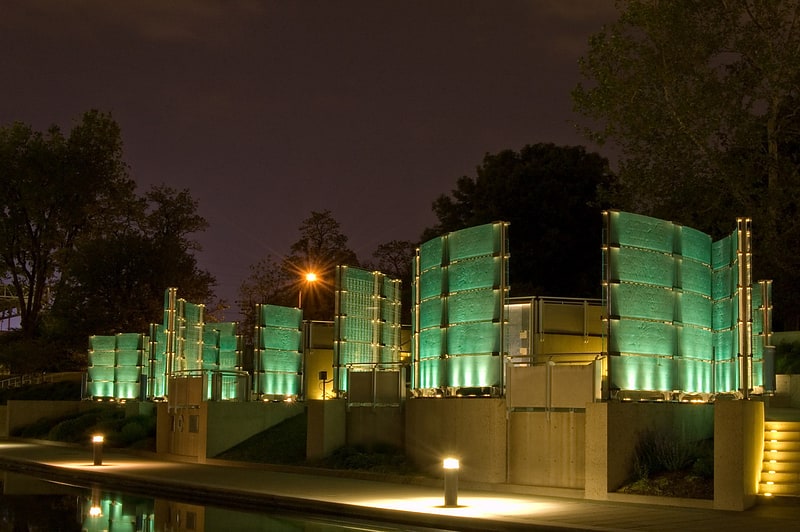
The Medal of Honor Memorial is a monument located in White River State Park in Indianapolis, Indiana, United States. It is dedicated in honor of all recipients of the Medal of Honor, the United States military's highest award for valor. The memorial was unveiled May 28, 1999, during Memorial Day weekend. The memorial is part of the Indiana War Memorials Commission.[34]
Address: White River State Park, 46204 Indianapolis (Downtown Indianapolis)
Madame Walker Theatre Center
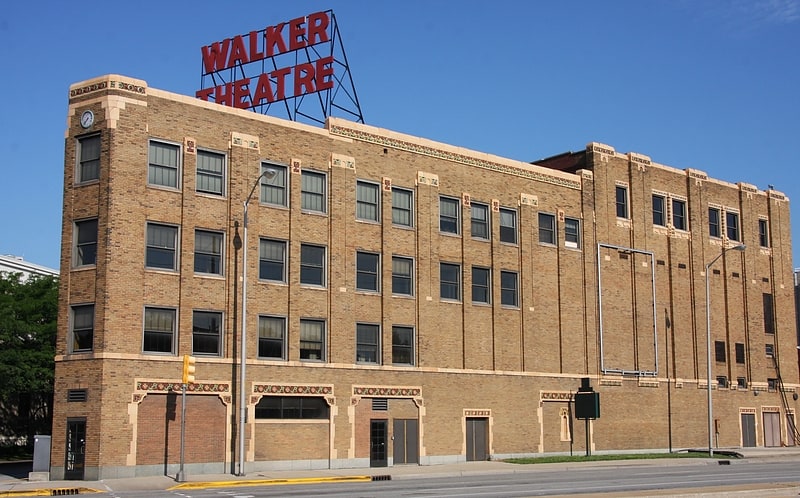
Building in Indianapolis, Indiana. The Madam C. J. Walker Building, which houses the Madam Walker Legacy Center, was built in 1927 in the city of Indianapolis, in the U.S. state of Indiana, and as Madam C. J. Walker Manufacturing Company, it was designated a National Historic Landmark in 1991. The four-story, multi-purpose Walker Building was named in honor of Madam C. J. Walker, the African American hair care and beauty products entrepreneur who founded the Madam C. J. Walker Manufacturing Company, and designed by the Indianapolis architectural firm of Rubush & Hunter. The building served as the world headquarters for Walker's company, as well as entertainment, business, and commercial hub along Indiana Avenue for the city's African American community from the 1920s to the 1950s. The historic gathering place and venue for community events and arts and cultural programs were saved from demolition in the 1970s. The restored building, which includes African, Egyptian, and Moorish designs, is one of the few remaining African-Art Deco buildings in the United States. The Walker Building was added to the National Register of Historic Places in 1980.[35]
Address: 617 Indiana Ave, 46202-3192 Indianapolis (Downtown Indianapolis)